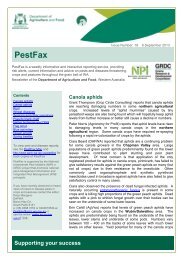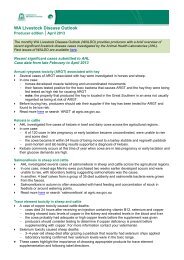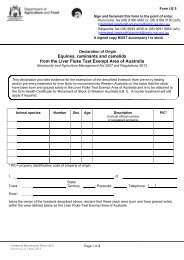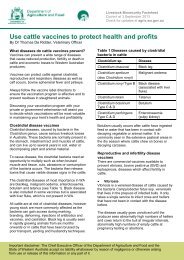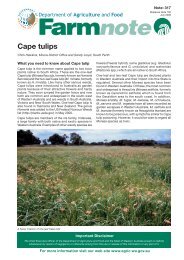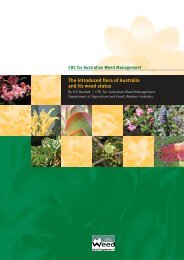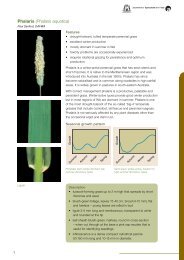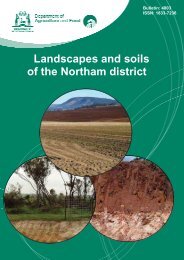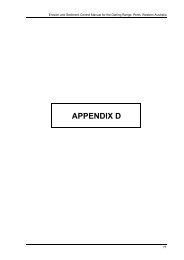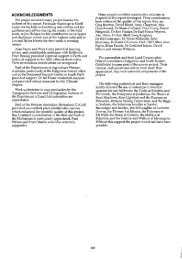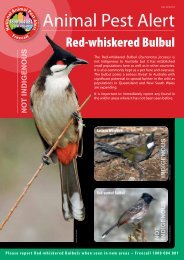Nasal bots in sheep - Department of Agriculture and Food
Nasal bots in sheep - Department of Agriculture and Food
Nasal bots in sheep - Department of Agriculture and Food
Create successful ePaper yourself
Turn your PDF publications into a flip-book with our unique Google optimized e-Paper software.
<strong>Department</strong> <strong>of</strong><br />
<strong>Agriculture</strong> <strong>and</strong> <strong>Food</strong><br />
Note: 575<br />
July 2013<br />
Replaces Note: 479<br />
Farmnote<br />
<strong>Nasal</strong> <strong>bots</strong> <strong>in</strong> <strong>sheep</strong><br />
Roy Butler, District Veter<strong>in</strong>ary Officer<br />
<strong>Nasal</strong> <strong>bots</strong> are the maggots or larvae <strong>of</strong> the<br />
<strong>sheep</strong> nasal bot fly, Oestrus ovis. This pest<br />
possibly orig<strong>in</strong>ated from Africa, but is now present<br />
throughout the world wherever there are <strong>sheep</strong><br />
<strong>and</strong> goats. <strong>Nasal</strong> <strong>bots</strong> were accidentally <strong>in</strong>troduced<br />
<strong>in</strong>to Australia <strong>in</strong> <strong>sheep</strong> <strong>in</strong> the early 1900s. They<br />
were first recorded <strong>in</strong> Western Australia <strong>in</strong> 1919.<br />
They may be less common <strong>in</strong> areas where the<br />
macrocyclic lactone (ML) anthelm<strong>in</strong>tics, such as<br />
ivermect<strong>in</strong>, have been frequently used.<br />
<strong>Nasal</strong> <strong>bots</strong> are normally found <strong>in</strong> <strong>sheep</strong> <strong>and</strong> goats<br />
but the bot flies occasionally target humans, dogs<br />
<strong>and</strong> cats. In these species <strong>bots</strong> may be found <strong>in</strong><br />
the throat or eye - where they can cause severe<br />
irritation - or <strong>in</strong> the nasal passages where they can<br />
cause breath<strong>in</strong>g difficulty. Bots don’t develop to<br />
maturity <strong>in</strong> species other than <strong>sheep</strong> <strong>and</strong> goats.<br />
<strong>Nasal</strong> bot (larvae <strong>of</strong> nasal bot fly) <strong>in</strong> a <strong>sheep</strong>’s<br />
head. Photo courtesy C Barrett.<br />
Life cycle <strong>of</strong> the nasal bot fly<br />
Fly activity is seasonal <strong>and</strong> generally peaks <strong>in</strong><br />
spr<strong>in</strong>g <strong>and</strong> late summer when temperatures<br />
exceed 20 degrees C, however the pattern <strong>of</strong> fly<br />
activity varies between regions.<br />
The female fly has a life span <strong>of</strong> approximately two<br />
days <strong>in</strong> summer <strong>and</strong> four weeks <strong>in</strong> cold weather.<br />
Dur<strong>in</strong>g its life one fly may produce up to ~500<br />
larvae. In cold climates, such as Russia or Siberia,<br />
the flies have only 1–2 generations each year, but<br />
<strong>in</strong> hotter places, such as much <strong>of</strong> Australia, there<br />
may be 5–6 generations <strong>of</strong> flies each year.<br />
The <strong>sheep</strong> nasal bot fly deposits larvae, not eggs,<br />
on its host, unlike the related bot fly <strong>of</strong> horses<br />
(Gasterophilus species), which attaches eggs to<br />
horse hair. Once larvae have been deposited at<br />
the <strong>sheep</strong>’s nostrils, they move <strong>and</strong> grow with<strong>in</strong><br />
the nasal cavity <strong>and</strong> the frontal <strong>and</strong> possibly<br />
maxillary s<strong>in</strong>uses. They develop through three<br />
stages, or <strong>in</strong>stars. When mature, <strong>and</strong> about 3 cm<br />
long, the larvae return down the nasal passages<br />
to be sneezed out <strong>and</strong> pupate <strong>in</strong> soil. The rate <strong>of</strong><br />
development <strong>of</strong> larvae with<strong>in</strong> the <strong>sheep</strong>’s head is<br />
highly variable. From deposition at the <strong>sheep</strong>’s<br />
nostrils to emergence, could take as long as 10<br />
months or as short as 6 weeks.<br />
In a s<strong>in</strong>gle <strong>sheep</strong> there could be as many as 75<br />
larvae at various stages <strong>of</strong> development, but it<br />
is rare that a <strong>sheep</strong> has more than 20 larvae.<br />
Probably no more than 20% <strong>of</strong> larvae <strong>in</strong> a <strong>sheep</strong>’s<br />
head reach maturity.<br />
Important disclaimer<br />
The Chief Executive Officer <strong>of</strong> the <strong>Department</strong> <strong>of</strong> <strong>Agriculture</strong> <strong>and</strong> <strong>Food</strong> <strong>and</strong> the State <strong>of</strong> Western<br />
Australia accept no liability whatsoever by reason <strong>of</strong> negligence or otherwise aris<strong>in</strong>g from the use or<br />
release <strong>of</strong> this <strong>in</strong>formation or any part <strong>of</strong> it.<br />
More <strong>in</strong>formation agric.wa.gov.au
Expelled <strong>bots</strong> take one to five days <strong>in</strong> soil to form<br />
pupae. Flies emerge from these pupae <strong>in</strong> ~ 3–4<br />
weeks <strong>in</strong> summer <strong>and</strong> ~ 4–9 weeks <strong>in</strong> w<strong>in</strong>ter.<br />
The duration <strong>of</strong> each stage <strong>of</strong> the nasal bot fly’s<br />
life cycle is highly variable, ma<strong>in</strong>ly dependent on<br />
temperature.<br />
Effects <strong>of</strong> nasal <strong>bots</strong> on <strong>sheep</strong><br />
Sheep exhibit dist<strong>in</strong>ctive behaviour when bot flies<br />
are active, dur<strong>in</strong>g the warmest parts <strong>of</strong> the day <strong>in</strong><br />
warm-to-hot periods <strong>of</strong> the year. When the flies<br />
are attempt<strong>in</strong>g to deposit their larvae just <strong>in</strong>side<br />
<strong>sheep</strong>’s nostrils the <strong>sheep</strong> show typical disturbed<br />
behaviour. They snort <strong>and</strong> stamp their front feet,<br />
run <strong>in</strong> short bursts with their noses almost on the<br />
ground, <strong>and</strong> bury their noses <strong>in</strong>to the fleeces <strong>of</strong><br />
other <strong>sheep</strong> or <strong>in</strong>to the soil. Sheep may congregate<br />
<strong>in</strong> shaded places where the flies are less active.<br />
The signs shown by affected <strong>sheep</strong> vary,<br />
possibly depend<strong>in</strong>g on the number <strong>and</strong> stage<br />
<strong>of</strong> development <strong>of</strong> the larvae. Sheep may show<br />
no signs at all, or may have a watery or thick<br />
discharge from one or both nostrils, sometimes<br />
conta<strong>in</strong><strong>in</strong>g flecks <strong>of</strong> blood. Sheep may have<br />
difficulty <strong>in</strong> breath<strong>in</strong>g, <strong>and</strong> may sneeze or cough.<br />
The economic impact <strong>of</strong> nasal <strong>bots</strong> is debatable.<br />
In Australia they are generally not believed to be<br />
<strong>of</strong> economic importance. In some other countries<br />
nasal <strong>bots</strong> are believed to cause production loss<br />
due to reduced body <strong>and</strong> fleece growth. They<br />
have also been suspected <strong>of</strong> suppress<strong>in</strong>g normal<br />
immunity, predispos<strong>in</strong>g to secondary bacterial<br />
<strong>in</strong>fections <strong>in</strong>clud<strong>in</strong>g chronic s<strong>in</strong>usitis <strong>and</strong> necrosis<br />
<strong>of</strong> bone, <strong>and</strong> Pasteurella pneumonia. <strong>Nasal</strong> <strong>bots</strong><br />
do not affect the ability <strong>of</strong> rams to f<strong>in</strong>d, by smell,<br />
ewes <strong>in</strong> oestrus.<br />
Diagnosis<br />
There is no commercially available test, <strong>of</strong> <strong>sheep</strong>’s<br />
blood or nasal discharge, which will identify<br />
<strong>in</strong>fected <strong>sheep</strong>.<br />
The peculiar behaviour <strong>of</strong> <strong>sheep</strong> when the bot flies<br />
are active is very good evidence that some <strong>sheep</strong><br />
<strong>in</strong> the flock are, or are likely to become <strong>in</strong>fected.<br />
The flies themselves are a little smaller than the<br />
common blow fly but are rarely seen. A nasal<br />
discharge, with or without cough<strong>in</strong>g <strong>and</strong> sneez<strong>in</strong>g,<br />
would arouse suspicion but it is not diagnostic for<br />
nasal bot <strong>in</strong>festation.<br />
Sometimes a diagnosis is made <strong>in</strong>cidentally when,<br />
while shear<strong>in</strong>g or drench<strong>in</strong>g a <strong>sheep</strong>, a bot is<br />
expelled from the <strong>sheep</strong>’s nostrils onto the h<strong>and</strong>ler.<br />
Similarly, expelled <strong>bots</strong> are sometimes found <strong>in</strong><br />
water or feed troughs. Bots may be more common<br />
<strong>in</strong> horned breeds <strong>and</strong> sometimes when <strong>sheep</strong> are<br />
dehorned <strong>bots</strong> may emerge from the horn core.<br />
The signs <strong>in</strong> <strong>sheep</strong> might resemble some other<br />
diseases that affect <strong>sheep</strong> behaviour, or even an<br />
exotic disease. Possible alternative diagnoses<br />
should always be considered <strong>and</strong> excluded before<br />
mak<strong>in</strong>g a diagnosis <strong>of</strong> nasal bot <strong>in</strong>festation. If <strong>in</strong><br />
doubt, seek veter<strong>in</strong>ary advice.<br />
Goats rarely show any signs <strong>of</strong> <strong>in</strong>festation.<br />
Treatment with an effective product can be used<br />
as an <strong>in</strong>direct method <strong>of</strong> diagnosis. If, follow<strong>in</strong>g<br />
treatment, the signs disappear, it is reasonable<br />
to make a retrospective diagnosis <strong>of</strong> nasal bot<br />
<strong>in</strong>festation.<br />
Treatment<br />
Treatment with an anthelm<strong>in</strong>thic solely for nasal<br />
<strong>bots</strong> is not recommended unless it is believed<br />
the health <strong>of</strong> animals is be<strong>in</strong>g affected by these<br />
parasites. The current treatment for nasal <strong>bots</strong> is<br />
usually an ML worm drench, such as ivermect<strong>in</strong> or<br />
abamect<strong>in</strong>, or a different drench, closantel. These<br />
compounds are effective <strong>and</strong> safe, when given at<br />
label dose rates.<br />
Control or eradication?<br />
The adm<strong>in</strong>istration <strong>of</strong> one or two drenches<br />
conta<strong>in</strong><strong>in</strong>g an ML drench to the whole flock <strong>in</strong> late<br />
summer or autumn might give some control <strong>of</strong><br />
these pests but it is not recommended; it would<br />
be contrary to current recommended worm control<br />
practices <strong>and</strong> could contribute to the already high<br />
level <strong>of</strong> worm resistance to these chemicals.<br />
Eradication <strong>of</strong> nasal <strong>bots</strong> would be very difficult<br />
because <strong>of</strong> the non-synchronous nature <strong>of</strong><br />
development <strong>of</strong> larvae <strong>in</strong> <strong>sheep</strong> <strong>and</strong> <strong>in</strong> soil to<br />
pupae <strong>and</strong> then flies.<br />
Copyright © Western Australian <strong>Agriculture</strong> Authority, 2013<br />
Copies <strong>of</strong> this document are available <strong>in</strong> alternative formats upon request.<br />
ISSN 0726-934X<br />
20133427-07/13<br />
3 Baron-Hay Court South Perth Western Australia 6151<br />
Telephone: (+61 8) 9368 3333 Email: enquiries@agric.wa.gov.au Website: agric.wa.gov.au



